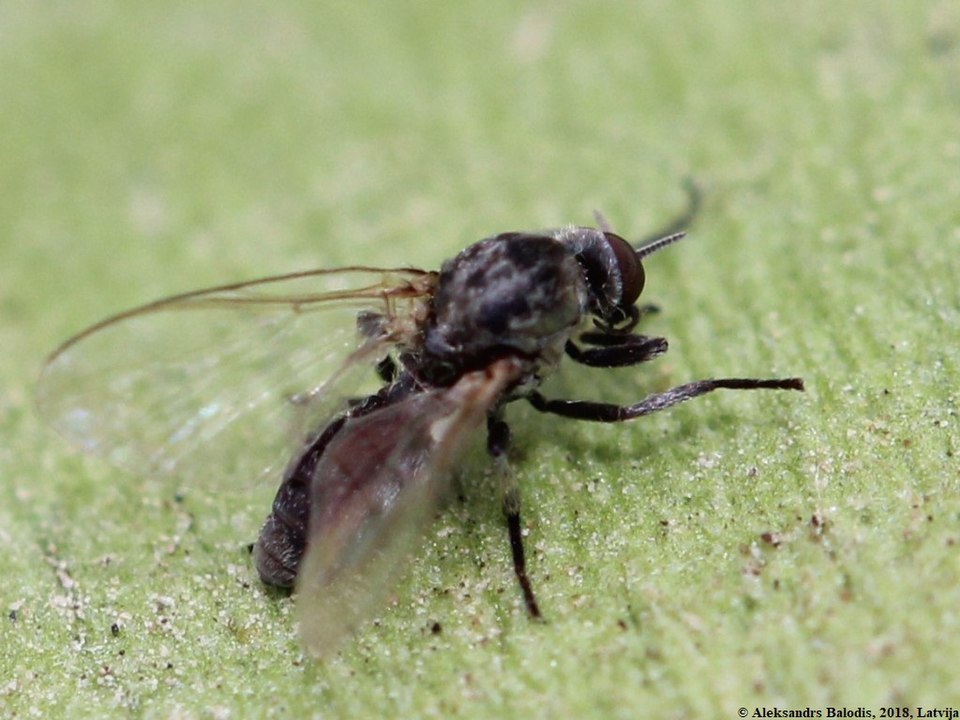Black flies are small, dark-coloured insects belonging to the family Simuliidae. Of the world’s more than 2,300 species, at least 164 are found in Canada. Black flies reproduce in streams and are found all across Canada. They are particularly common in northern temperate and subarctic regions. Because female black flies need to feed on blood to lay eggs, their biting can be a nuisance to humans and other animals. Among the most common and notorious black flies in Canada are Simulium truncatum and Simulium venustum.

Description
Black flies are 1–5 mm-long flies with short legs and broad wings. Females in particular have a slightly humpbacked shape. Although generally dark-coloured, different species may be black, yellowish orange or brownish grey.
Females have biting mouthparts, which they use to cut into the skin of birds and mammals to draw blood. The blood is then sucked up along a hollow channel. (About 2.4 per cent of species globally do not feed on blood at all.) Males do not bite and are rarely seen. Both sexes consume nectar to give them energy to fly, while females use nutrients from blood to produce eggs.
Larvae are aquatic, greenish gray or brown, and have large fan-like mouthparts that they use to trap small food particles suspended in the current. Larvae also have a set of posterior claws. These claws keep them attached to a silken pad, which is spun on a submerged surface. The cone-shaped pupae remain attached to the same spot, nestled in a silk cocoon.
Distribution and Habitat
Black flies are found worldwide, except in Antarctica. They can be found virtually anywhere there is flowing water to serve as habitat for larvae. In Canada, they are especially abundant in northern wooded areas and near large rivers and lake outlets. Unlike mosquitoes, adult black flies are mainly active during the day.
Reproduction and Development

Eggs (150–600 per female) may be laid on objects in running water or scattered over the water’s surface. Larvae attach to submerged rocks or vegetation and generally complete development in 2–3 weeks, depending on water temperatures and food availability. Pupae are inactive and do not feed. However, they can obtain oxygen from both water and air, allowing them to survive in case water levels drop. Adults emerge in a bubble of air, formed inside the cocoon just before moulting, which they ride to the surface. The life cycle of a black fly can be completed in 3–4 weeks. Some species may go through multiple generations in a year. Most black fly species spend winter in the egg or larval stage, with adults appearing in late spring and early summer.
Ecology
Black fly larvae are an important part of aquatic food webs. Larger rivers can host over 600,000 larvae per square metre and can produce close to a billion adults per kilometre per day. Larvae are eaten by fish and aquatic invertebrates, while adults are prey for birds. In the act of feeding, black fly larvae transform fine organic particles into nutrient-rich fecal matter. This fecal matter fertilizes riverbanks and provides food for organisms further downstream. In large northern rivers, the total mass of fecal matter can exceed several hundred tonnes in one day. Silk pads left behind by larvae can also trap debris to form small, sheltered homes for algae, bacteria, and invertebrates.
Interaction with Humans
Black flies can be quite annoying to humans. Species that bite humans are drawn to subtle odours in sweat. They tend to swarm around the head and skin before biting, and will bite any exposed skin, especially on the wrists, ankles, waistline, neck and hairline. Their bites normally leave a small welt and a droplet of blood, and may itch for several days. In North America, black flies are not known to transmit any diseases. However, in Africa, Mexico, Central America, Brazil, Venezuela and Yemen, they can transmit nematodes (i.e. roundworms) causing river blindness (onchocerciasis) in humans.
In Canada, black flies can also be a serious threat to livestock, such as in northern Alberta and Saskatchewan. In these provinces, black fly attacks have caused reduced grazing and weight loss in cattle. The saliva of one species, Simulium arcticum, contains a toxin that can cause anaphylactic shock, and sometimes death, in cattle. Outbreaks of this species have been blamed for losses of hundreds of animals at a time.
A Canadian folk song by Wade Hemsworth, “The Black Fly Song,” recounts the torment caused by these insects while surveying for a hydroelectric dam in Northern Ontario. The song was also adapted for the National Film Board animated film, Blackfly.
Black fly bites can be avoided by wearing light-coloured clothing that covers the wrists, ankles, and belt line, and by applying commercial insect repellents to the skin and clothing. North American Indigenous peoples have also deterred biting flies using naturally occurring insect repellents found in bracket fungi and in plants such as fireweed and sweetgrass.

 Share on Facebook
Share on Facebook Share on X
Share on X Share by Email
Share by Email Share on Google Classroom
Share on Google Classroom



